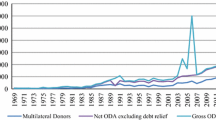Abstract
This paper investigates the need for providing follow up business development instruments to small rural businesses that have benefited from grant aid assistance schemes. A sample of 76 small rural businesses in lagging areas of insular Greece is included in the present survey, and ranks thirteen possible business growth instruments. It is found that business development instruments are ranked according to each firm's economic and human capital characteristics. Furthermore, most firms need the concurrent provision of more than one instrument. Likewise, a mixture of business specific schemes, regulatory interventions and infrastructure projects, better serves their business development needs. Results from the present survey indicate that an integrated business development strategy in lagging areas of Greece should be supported by modern, flexibly tailored combinations of assistance, using complex, multi-instrument sets of support to development efforts.
Similar content being viewed by others
References
Audretsch, D. B., 1995, Innovation and Industry Evolution, Cambridge: MIT Press.
Barkham, R. J., 1994, ‘Entrepreneurial Characteristics and the Size of the New Firm: A Model and an Econometric Test’, Small Business Economics 6, 117–125.
Bates, Timothy, 1990, ‘Entrepreneur Human Capital Inputs and Small Business Longevity’, The Review of Economics and Statistics 72, 551–559.
Bates, Timothy, 1994, ‘Determinants of Survival and Profitability Among Asian Immigrant-Owned Small Businesses’, Social Forces 72, 671–689.
Bates, Timothy and Alfred Nucci, 1990, ‘An Analysis of Small Business Size and Rate of Discontinuance’, Centre for Economic Studies Discussion Papers No. 90-2.Washington D.C.: Bureau of the Census.
Cameron, A. and P. Triverdi, 1990, ‘Regression Based Tests for Overdispersion in the Poisson Regression Model’, Journal of Econometrics 46, 347–364.
Dunne, T., 1994, ‘Plant Age and Technology Use in U.S.Manufacturing Industries’, Rand Journal of Economics 13, 523–542.
Evans, David, 1987, ‘The Relationship Between Firm Size, Growth, and Age’, The Journal of Industrial Economics 35, 567–582.
Gale, Frederick H., 1998, ‘Rural Manufacturing on the Crest of the Wave: A Count Data Analysis of Technology Use’, American Journal of Agricultural Economics 80, 347–359.
Greene, William, 1998, LIMDEP, version 7.0, New York: Econometric Software.
Liargovas, P, 1998, ‘The White Paper on Growth, Competitiveness and Employment and Greek Small and Medium Sized Enterprises’, Small Business Economics 11, 201–214.
Maddala, G. S., 1983, Limited Dependent and Qualitative Variables in Econometrics, Econometric Society Monographs, Cambridge: Cambridge University Press.
Nucci, Alfred, R., 1999, ‘The Demography of Business Closings’, Small Business Economics 12, 25–39.
Panizzolo, R., 1998, ‘Managing Innovation in SMEs: A Multiple Case Analysis of the Adoption and Implementation of Product and Process Design Technologies’, Small Business Economics 11, 25–42.
Storey, D. J., 1994, Understanding the Small Business Sector, Routledge, London.
Variyam, J. N. and D. Kraybill, 1994, ‘Managerial Inputs and the Growth of Rural Small Firms’, American Journal of Agricultural Economics 76, 568–575.
Woolgar, S. and J. Vaux, 1998, ‘Abilities and Competencies Required, Particularly by Small Firms, to Identify and Acquire New Technology’, Technovation 18, 575–584.
Wren, Colin, 1994, ‘The Build-Up and Duration of Subsidy-Induced Employment: Evidence from U.K. Regional Policy’, Journal of Regional Science 34, 387–410.
Wren, Colin, 1996a, ‘Reply to Subsidies, Additionality and Financial Constraints’, Journal of Regional Science 36, 501–508.
Wren, Colin, 1996b, Industrial Subsidies: The U.K.Experience. Hampshire: MacMillan Press.
Wren, Colin, 1998, ‘Subsidies for Job Creation: Is Small Best?’, Small Business Economics 10, 273–281.
Author information
Authors and Affiliations
Rights and permissions
About this article
Cite this article
Skuras, D., Dimara, E. & Vakrou, A. The Day After Grant-Aid: Business Development Schemes for Small Rural Firms in Lagging Areas of Greece. Small Business Economics 14, 125–136 (2000). https://doi.org/10.1023/A:1008163517068
Issue Date:
DOI: https://doi.org/10.1023/A:1008163517068




